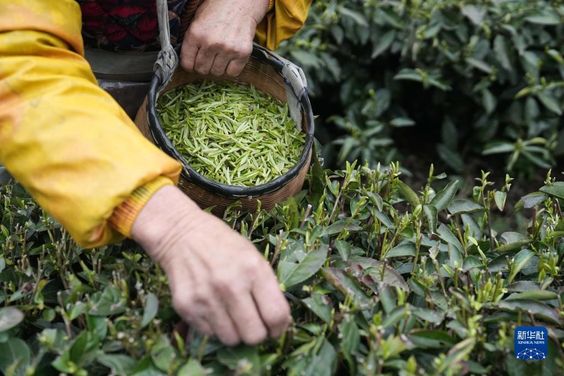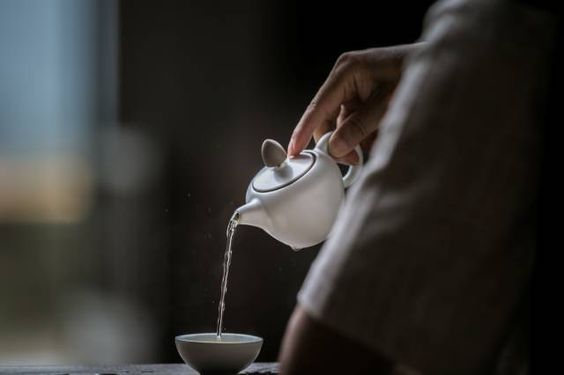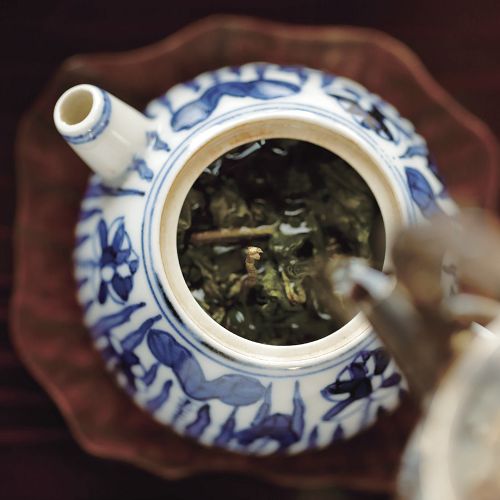‘Dark tea’, the name can be traced back to the third year of the Ming Jiajing (1524), the imperial censor Chen Lecture in the first trace. The name comes from the unique appearance of the finished tea - deep as night, like the colour of ink. dark tea, belonging to the post-fermented tea category, each piece of tea contains the precipitation of years and history as if telling an ancient and profound story.
A date with tea under the Thousand Buddha Mountain
Dark tea, a treasure originating from Yunnan, Guizhou, Sichuan, the two lakes and Guizhou, is like a low-profile and introverted wise man, quietly telling a thousand-year story. Behind the names of Hunan Porcha, Hubei Green Brick, Ya'an Border Tea, Anhui Yixian Ancha, and Yunnan Ripening Tea, there are regional characteristics and unique flavours. dark tea is not only a cup of tea that can be tasted, but also a witness of history and a cultural heritage.

Its uniqueness lies in its ability to cross the boundaries of time, and long-term preservation without decay. In the precipitation of the years, dark tea continues to ferment, like a blooming golden flower, blossoming in silence. Its aroma, with the passage of time and the more mellow, the more fragrant, so that people are intoxicated, as if in the ancient time tunnel.
Therefore, dark tea is known as the ‘tea of life’. It is not only a kind of drink, but also a kind of artwork with high collection value. Each dark tea is the crystallisation of time and wisdom and is worth savouring and treasuring.
Dark Tea Producing Areas
History of Dark Tea
Dark tea traced back to the Tang 903, the Tang and Song Dynasty tea horse trading distribution centre for Sichuan Ya'an and Shaanxi Hanzhong, people back horseback arrived in Tibet, transported about 2 to 3 months away, during which the rain blew the sun, tea is often drenched and dried in the sun, this dry, wet alternately, resulting in the tea in the microbial effect of continuous fermentation, which led to the original tea is not the same. Later, people killed the green, kneading after the addition of a pile and then drying the tea production process, dark tea is also known as ‘tea on horseback’ from this.

Tibetan tea is the originator of dark tea
Ya'an, Sichuan is the origin of Tibetan tea, after 32 kinds of ancient methods, also known as the South Road tea. It has a history of 1300 years. During the Jiajing period of the Ming Dynasty, the Jingyang merchant gang from Shaanxi Province came to Ya'an one after another to invest in the border tea industry. They had strong capital, and business, from the Ming to Qing Dynasty founded more than 10 tea, and the scale of operation soon exceeded the local Sichuan gang, accounting for two-thirds of Ya'an tea.
①‘Red’ refers to the red colour of the soup;
②‘Strong’ refers to the tea flavour being authentic and refreshing;
③‘Chen’ refers to the longer the old tea flavour, the thicker the old tea flavour;
④‘Mellow’ means not astringent and not bitter, smooth and sweet and mellow.
Anhua Dark Tea history:
History can be traced back to more than 1400 years ago in the Tang Dynasty, ‘Drainage River thin slice’, the rise of the Tang, Sheng in Song, Ming and Qing for the tribute, known as the antique can drink, the more fragrant the more collectable value. ‘Tea and horse market, the migratory birds into the dynasty, drive the horse city tea and return.
During the three kingdoms period, wu, shu cantonment yiyang, and guan yu had gabion wrapped tea for the soldiers to relieve the disease, gabion is the unique packaging form of anhua dark tea. 1972-1974 Changsha Mawangdui One, three han tomb unearthed a ‘a bamboo bamboo’, by the test that the tea is a box, the box dark The dark granular objects in the box were sliced by microscope and confirmed to be Anhua dark tea, which matched with the dark tea package unearthed in Mawangdui. Then the history of Anhua dark tea is at least 2300 years.
During the Jiajing period of the Ming Dynasty, the lower Zijiang River became an important starting point of the Silk Road and the Tea Horse Road in the south. The Qing Dynasty dark tea process is a great success, the introduction of the ‘Qianliang tea’, known as ‘the world's king of tea’ by modern people. Today, the only remaining one of the Forbidden City, ‘a thousand two tea’ has become a priceless treasure. At the end of the Qing Dynasty, Anhua tea was famous all over the world, tea industry was unprecedented. Border rumour has it that ‘drink wine to drink Yilit, drink tea to drink Yiyang tea’, and Anhua tea has always been ‘cliffs and water, not planted since the birth of’ excellent quality, is the first choice of the upper echelons of the feudal society of the tea.
The process of dark tea
The dark bricks are killed, initial kneading, stacking, re-kneading, baking, and the gross tea is pressed into shape and placed in a cool and ventilated place for 10-15 days. Qianliang Tea, Bailiang Tea, etc. are dried using the 49-day drying process of sun exposure and night exposure to allow the moisture to dry slowly.

Liquor Killing
As the raw materials of dark tea are coarse and old, generally, except for rainwater leaves, dew leaves and young buds and leaves, they should be sprinkled with water in a ratio of 10:1, to kill evenly and thoroughly. The fresh leaves are put into the pot at high temperature, and the hands are evenly turned over and fried quickly, when it is hot, it is called a ‘bright fork’ with a tea fork. Fry until there is water vapour to the right hand holding a fork, the left hand holding the grass handle, turn the roll and stir-fry known as ‘Wo fork’. To be soft tea with viscous, dark green without lustre grass gas elimination aroma shows folding thick stalks are not easy to break uniformly, that is, the end of the killing, but also machine killing.
First kneading
The raw materials of dark tea are coarse and old, the kneading should master light pressure, short time, and slow kneading. To be dark tea leaves into strips, tea juice overflow floating on the surface, coarse and old leaves folded, for the end of the initial kneading.
Warming
It is the key process to form the colour, aroma and taste of dark tea. The back window and ground are clean and protected from light, the room temperature is above 25℃ and the humidity is about 85%. Tea billets stacked about 1 metre high, covered with wet cloth, straw raincoat and other things to keep warm. Pile about 24 hours, the middle of the heap once, to be the surface of the tea billets appear water droplets, leaf colour from dark green to yellow-brown, with the lees gas or sour and spicy odour, the tea heap is hot, the viscosity of the tea ball becomes small, a hit that is, that is, the Wojiu moderately.
Roasting
It is the last process in the initial production of dark tea, burning pine wood on the seven-star stove, forming the tea leaves into oil dark through roasting, with the aroma of pine smoke. The special iron fork is used to turn the roasting, so that the upper, middle and lower layers of tea leaves are dried to the right degree, i.e., the tea is roasted and dried naturally.
